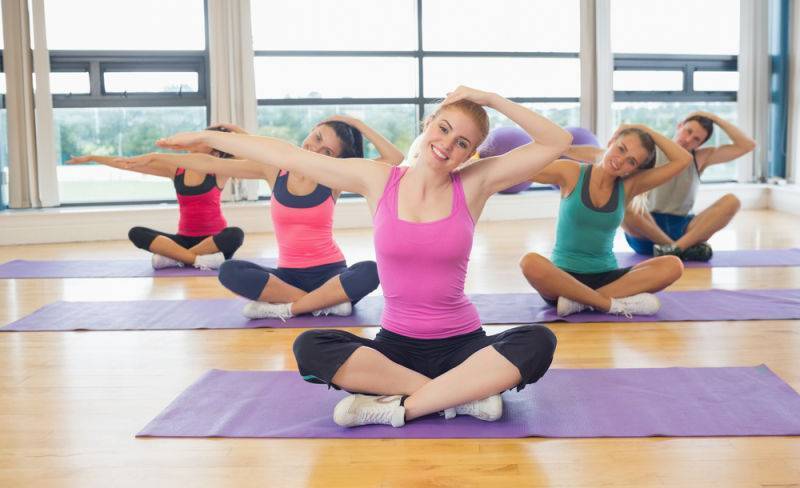Yoga Exercise, How Yoga Improves Your Health

If you’re a yoga practitioner, you already know some of the benefits yoga has on your health—you’re sleeping better or haven’t had to worry about a cold or flu in quite a while. You may be feeling more at ease and there is just a relaxed mode in general. But yoga has more benefits than just making you feel better. It interferes with your physical health and helps with maintaining a healthy lifestyle. Keep reading for more info on why you should opt practicing yoga soon!
Yoga improves your flexibility
The most obvious and the first of many benefits from practicing yoga is improved flexibility. Even though you will feel that the routines are very hard at first, you will find that your body responds well and can pull off seemingly impossible poses if you stick with your practice sessions. These will eventually become so good for the body that you will notice the aches and pains start to disappear.
It builds muscle power
Strong muscles do more than just look great, they are protection against conditions like arthritis and back pain. Lifting weights in the gym may give you good muscles too but you will miss out on the flexibility offered by yoga when you work out only at a gym.
It perfects your posture
A poor posture will result in back and neck pain while also creating other issues in your muscles and joints. When you slouch, the body compensates by flattening the inward curves in your neck and back, this causes pain and gradually deteriorates the bones and result in arthritis of the spine.
It prevents cartilage and joint breakdown
Yoga prevents degenerative arthritis or lessens the disability in cartilage that is not used normally. Joint cartilage works like a sponge; it accepts fresh nutrients only when its fluid is squeezed out and a new supply can be absorbed up. Without proper nourishment, neglected areas of cartilage can slowly wear out, exposing the underlying bone.
It plays a role in protecting your spine
Spinal disks are the shock absorbers located between the vertebrae that can herniate and compress nerves. This is the only way they get their nutrients. If your routine is well-balanced asana practice with plenty of back-bends, twists and forward bends, this will help in keeping your disks agile.
Betters your bone health
It is well known that weight-bearing exercises will help in strengthening bones and help in protecting the bones against osteoporosis. Many postures in yoga have poses that require you to lift your own weight. Yoga practice was seen in a study to increase bone density in the vertebrae and the lowered levels of the stress hormone cortisol to help retain calcium in the bones.
Increases your blood flow
Yoga gets your blood flowing through the relaxation exercises. Yoga can help your circulation, especially in your limbs through this. It helps in getting more oxygen to your cells, which will then function better. The inverted poses in yoga, such as the Headstand and Handstand encourage venous blood from the legs and pelvis to flow back to the heart. Here it can be pumped to the lungs to be oxygenated. Yoga is also known to boost levels of hemoglobin and red blood cells in the blood and cuts the level of clot-promoting proteins in the blood. This will help in keeping heart attacks and strokes at bay because blood clots are often the cause of these sudden killers. Yoga can also help you to loose some weight, but the best way is to follow a diet.
Drops your blood pressure
Savasana (Corpse Pose) is associated with the drop in systolic blood pressure (the top number) and a 15-point drop in diastolic blood pressure (the bottom number—and the higher the initial blood pressure, bigger is the drop in the blood pressure.
It regulates adrenal glands
The adrenal glands normally secrete cortisol in response to an acute crisis. This temporarily boosts immune function in the body. In case the cortisol levels in your body refuse to go down even after the crisis, they can weaken the immune system. Yoga helps in maintaining a healthy regulation in adrenal glands.
Yoga lowers blood sugar
Yoga lowers blood sugar and LDL cholesterol and boosts HDL cholesterol, the bad and good cholesterol present in the body respectively. In people with diabetes, yoga is found to lower blood sugar in many ways: by lowering cortisol and adrenaline amount, encouraging weight loss, and improving responsiveness to the results of insulin. Getting your blood sugar levels down will decrease the risk of diabetes related problems like heart attack, kidney failure, and loss of eyesight. Doing exercise also helps to detox and prevent drug addiction. What is drug addiction? Addiction is defined as a chronic, relapsing brain disease that is characterized by compulsive drug seeking and use, despite harmful consequences. It is considered a brain disease because drugs change the brain—they change its structure and how it works. These brain changes can be long-lasting, and can lead to the harmful behaviors seen in people who abuse drugs.
Maintains the nervous system
Some experts in yoga have learned how to control their bodies in extraordinary ways through yoga. Many of these are mediated by the nervous system. Scientists have monitored yogis who could influence unusual heart rhythms, generate distinct brain-wave patterns, and by using a meditation technique, also raise the temperature of their hands by 15 degrees (Fahrenheit).
Gives your lungs more breathing space
Yogis tend to take fewer breaths of greater volume, which is both calming and more efficient. Yoga has been shown to improve many different measures of lung function. Yoga also promotes breathing through the nose, which is the best way to filter the air, warms it (cold air is likely to trigger an asthma attack in people who are sensitive to it), and removes pollen and dirt from it that you’d rather not take into your lungs. It’s important to understand reasons why your nervous system can start to fail, and one of those reasons is to abuse drugs.
Yoga also boosts the immune system functionality
Meditation has the strongest scientific support in boosting the immune system functions in your body. This means that yoga can raise antibody levels in response to a vaccine and lower it when required, especially in mitigating an inappropriately vigorous immune function in an autoimmune disease like psoriasis.

